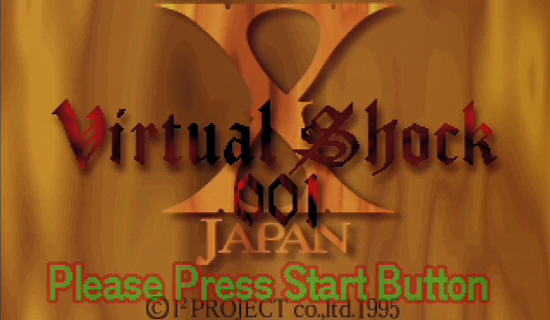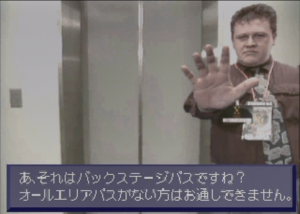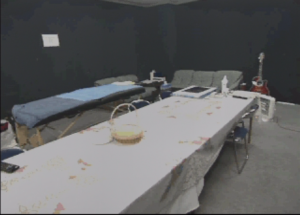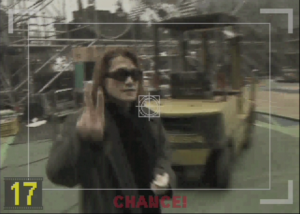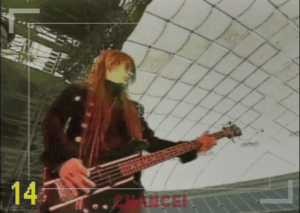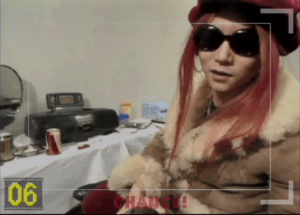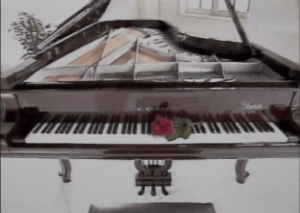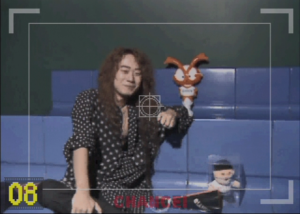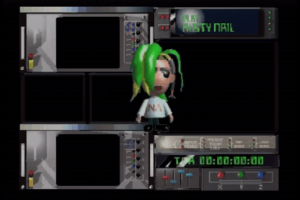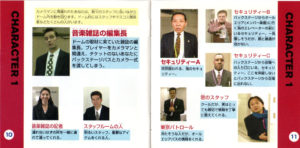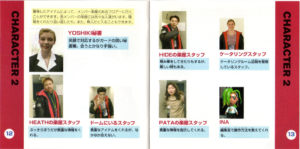If you’re reading this article, there’s a good chance that you already know who X Japan is. But if you don’t, they’re possibly the most internationally popular Japanese rock band. Though they weren’t signed to CBS Sony records until 1989, they’d already built a name for themselves on the indie scene long before. And they took the world of rock music by storm in Japan by basing their sound around power/speed metal, with a lot of symphonic influence (from Yoshiki’s classical music background, no doubt) that would follow later as they turned into more of a prog metal band. The lineup at the time of this release was Toshi (Vocals), Yoshiki (Drums and Piano), hide (Guitar), Pata (Guitar), and Heath (Bass).
Not only was their sound different, but their look as well. Like most successful visual kei bands, they’d eventually switch things up to a more standard rock band look. But they were one of the pioneers of the visual kei movement for much of their earlier career. This made them stand out quite a bit before visual kei really took hold, so their fans (who often mimicked their style) naturally stood out too. To help them feel better about this and thank them for their support, vocalist Toshi would often shout “mune hare!” (“Be proud!”) repeatedly to the crowd at the end of their early gigs.
(A live performance of the song “X” from the album Blue Blood, at Club Citta Kawasaki in 1990. This is a great example of what the band looked and acted like before they really hit it big. This is from before Heath joined the band, so the bassist here was Taiji. It also features Toshi shouting “mune hare!” (“Be proud!”) at the end.)
When this game was released in October 1995, X Japan was probably at the height of their popularity. They’d released Blue Blood and Jealousy to huge success, and had fully transitioned from a weird visual kei heavy metal band that only the weird kids listened to, into a rock band that basically everyone in Japan knew and loved. Their latest single “Rusty Nail” had been released the previous summer, and a new album was on its way next year. They were now so big that they had just played two days at the Tokyo Dome at the end of 1994 (though this was not their first time at the Dome by any means), which is the event that’s depicted in this very game: “aoi yoru” and “shiroi yoru” (“Blue Night” and “White Night”), held on 12/30/1994 and 12/31/1994. In fact this event was explicitly sponsored by Sega, since its full title was “Sega Saturn Presents X Japan Tokyo Dome 2 Days”. This can all be seen during the opening scene of the game.
(A live performance of the song “Silent Jealousy” from the Jealousy album in 1992. Taiji is still the bassist at this point, and you can see the visual kei look lightening up a bit from what it was back in the Blue Blood era.)
The game’s title is a parody on the long-running hide-coined slogan of the band, “Psychedelic Violence Crime of Visual Shock”. And since there is a “001” in the title, it can be assumed that the plan was to make this a series. The Japanese Wikipedia article even states that information on a second volume was published in a game magazine (they don’t say which one). However due to the stagnation of the Sega Saturn as a console, and X Japan’s deterioration as a band (in fact they would breakup about 2 years after the release of this game in 12/31/1997), the second volume never came to be.
(If you have 35 minutes that you’ll never get back, you can watch this performance X Japan’s crazy epic, Art of Life at Tokyo Dome in 1993. The actual song is that long (though there is a radio edit), and features Yoshiki actually banging on the piano at one point. Heath had also joined to replace Taiji on bass at this point.)
Virtual Shock is an FMV game where the player takes on a role that actually isn’t made very clear in the game itself (though it’s mentioned in the manual): You’re a fan that couldn’t get a ticket, but are mistaken for a cameraman. You’re given a camera, some film, and a basic press pass that doesn’t get you access to the entire backstage area of the Tokyo Dome. Your job is get whatever you need in order to gain access to all of the band members, take photos of them, and eventually enjoy the concert. You can only use your camera to take photos when you find one of the band members (the game will let you know when you can take them), and your film is limited (though you can find a couple more rolls throughout the game). So you can’t just snap photos like crazy.
(A performance of the song “Dahlia” from the album by the same name, from the Dahlia Tour Final at Tokyo Dome in 1996. I always have to listen to live versions of this song because it just isn’t the same to me if Toshi doesn’t scream “Dahlia!” sometime during the song! By this time they’d more or less shed their visual kei look.)
It’s basically just a matter of figuring out all of the conditions necessary to achieve those goals, but this isn’t nearly as complex as your average adventure game. In fact there are only two ways to get a game over at all: Getting caught by a specific security guard (who is always in a fixed location, so if you’re using a guide you’ll never run into them) or by giving hide the wrong alcohol (more on that interaction later). The manual even outlines all of the necessary items to make it through the game.
As you move around the back stage area, you aren’t really moving in real time. You choose the direction you want to move in, and you’ll get an FMV scene of walking, until you get the next point where you can choose a direction. In between those FMV scenes, you’re just looking at still images. And you’re doing all this to no sound whatsoever, except whatever’s in the FMV scenes (usually just someone talking, footsteps, or doors opening or closing). You spend way more time interacting with the random actors that play staff members than you do with the band members, and a good 3/4 of those actors are white people speaking English. The acting caliber is exactly what you would expect from an FMV game too. My favorite line is “You’re one of those camera men, right?”.
(An example of some of the quality acting you can expect in this game, courtesy of this play-through video from Saturn Memories on YouTube)
Of course the big draw here is being able to interact with the band members, right? Well you might be a little disappointed at the level of interaction that’s available. The only one that really even talks to the camera is hide (which lines up with what others have said about his loving relationship with his fans, repeatedly after his death). As mentioned above, there’s a scene where a staff member in his room asks you to bring him some alcohol. When you go see the lady who works at catering, you can choose between sake, wine, or Wild Turkey. If you don’t choose sake, you get a game over. But if you do, you get a short scene with hide. He’s happy that you have such good taste, and invites you to sit down and have a drink with him. He also mentions that he and Pata are going to be drinking after the show, and invites you to come back and join them. Sadly that after-show part isn’t actually in the game!
(A compilation video of hide’s scenes for each of the liquor choices that you can bring back to him. His reaction to the wrong choices are pretty great, so be sure to watch it!)
Pata has a scene where he’s interacting with the camera a bit, though he doesn’t actually say anything. The same with Toshi, as he passes by the camera (flashing a peace sign) and says a word or two. Heath and Yoshiki only appear in the scenes where you’re taking photos of them during performances and rehearsal.
(On May 2nd 1998, hide was found dead in his apartment, hanged with a towel around his neck tied to a door knob. He’d had a successful solo career since 1994, and had only been back in Japan for about 5 days since returning from a trip to Los Angeles. Many later stated that this was so shocking, that they believed this to have been an accident rather than a suicide (Yoshiki is chief among them). Regardless, it was one of the biggest tragedies that the Japanese music world has ever seen. Above is some news footage of his death, with includes many distraught fans, as well as X Japan’s performance of Forever Love hide’s funeral service.)
If you go to certain floors or locations at certain points, you can see videos of performances of either Rusty Nail or Tears (the two latest singles as of release of the game). You get to pick when the camera cuts to what member to make your own video though. The polygonal character that guides you through how things work with the editor is actually hide’s friend, band member, and producer I.N.A. Once you complete all of the conditions to get into the stage area and finish the game, you see a video of the band saying their goodbyes to the audience after their New Years Eve concert as Tears plays over it. You also see any of the previously mentioned videos that you edited, and the photos of the band members that you took are shown over the credits.
(X Japan officially reunited in 2007, eventually bringing in Luna Sea guitarist Sugizo to fill hide’s role. They’ve been active on and off ever since then, with quite a few international performances. Their most recent one as of this writing was this performance from Coachella 2018.)
As you may have guessed, this isn’t really very much of a game. It’s more like an excuse to see some X Japan concert footage with game trappings. All of the performance footage found here was the only way to watch official footage from “White Night” until the DVD was finally released in 2007. So as an X Japan fan in 1995, that was probably a good enough reason to own it. If you’re not an X Japan fan though, there isn’t even a reason to give this game a second look, given that it doesn’t do anything remotely innovative as an FMV or adventure game. Still, even in Japan there weren’t too many games based on bands or musical artists, and X Japan was probably more deserving of that treatment than most. It’s just a pity that the band themselves weren’t featured a bit more.
